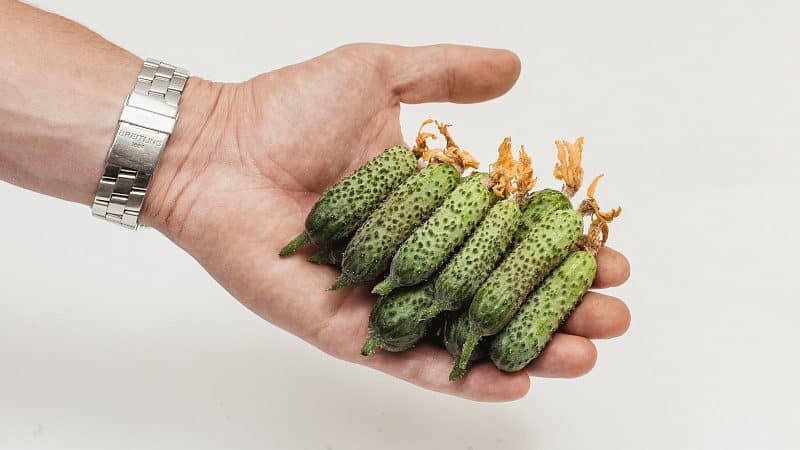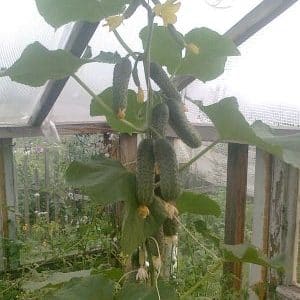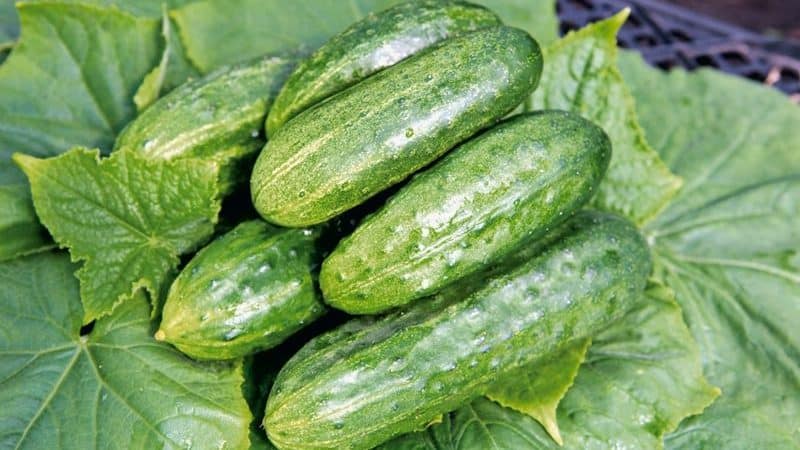Easy-to-care early cucumber “Temp” for salads and canning
Temp F1 is a hybrid of early ripening cucumbers. Thanks to excellent seed germination, high productivity and resistance to major diseases, the crop has gained enduring popularity among Russian gardeners. To get a rich harvest, it is enough to follow the rules of crop rotation and crop care. The vegetable is also grown at home - on the balcony or on the windowsill.
Description of cucumbers
The hybrid is intended for cultivation in protected ground. The culture is distinguished by bunch fruiting, the lateral shoots are poorly developed. The leaves are heart-shaped with 5 lobes, the stem has the appearance of a creeping whip, ending with tendrils with which the plant clings to the support.
The fruits are elongated, cylindrical, covered with lumpy green skin with white spines and light longitudinal stripes. On one node, 3–5 vegetables are formed, weighing from 50 to 80 g, 3–9 cm long. It blooms with single yellow inflorescences of medium size.

Distinctive features
Tempo differs from other cultures:
- seed germination rate of 95–99%;
- parthenocarpic fertilization (does not require pollination);
- lack of bitterness in fruits;
- the ability to grow at home;
- innate immunity to cultural diseases.
Important! Tempo F1 grows poorly in open ground: its vines dry out and the leaves turn yellow.
Composition and properties
The calorie content of the fruit is 13 kcal. 100 g of product contains:
- 0.8 g proteins;
- 2.4 g carbohydrates;
- 0.1 g fat.
Cucumbers not only have a refreshing taste, but also a rich chemical composition. These include:
- alimentary fiber;
- organic acids;
- provitamin A;
- biotin;
- B vitamins (thiamine, choline, folate, pyridoxine, riboflavin, pantothenic acid);
- ascorbic acid;
- alpha tocopherol;
- phylloquinone (vitamin K);
- vitamin PP;
- niacin;
- macroelements (sulfur, potassium, chlorine, calcium, phosphorus, magnesium, silicon, sodium);
- trace elements (aluminum, zinc, boron, iodine, iron, fluorine, chromium, manganese, selenium).
The fruits of the crop have beneficial properties:
- replenish the lack of fluid in the body;
- relieve heartburn;
- remove waste, toxins, heavy metal salts and excess water;
- improve digestion;
- prevent the formation of adipose tissue;
- reduce cholesterol levels;
- normalize blood pressure;
- treat sore gums;
- improve the condition of hair and nails;
- relieve pain from gout, arthritis;
- improve joint condition;
- relieve hangovers, remove harmful substances formed when drinking alcoholic beverages;
- reduce the concentration of uric acid;
- regulate kidney function.
Reference! Cucumbers are often used for cosmetic purposes due to their anti-inflammatory properties. Vegetables are cut into slices and placed on the eyes to get rid of bags and reduce swelling.
Characteristics

The table below shows the main characteristics of the hybrid:
| Bushes |
|
| Ripening time | From germination to the formation of pickles, 37-38 days pass, gherkins - 42-44 days. |
| Fruit | Pickles are 3–5 cm in length, gherkins are 7–9 cm. Weight is 50–80 g, diameter is 2–4 cm. |
| Taste and purpose | Pulp:
Cucumbers are consumed fresh, pickled, salted, and preserved for the winter. |
| Productivity | At the pickle stage - 9-10 kg/m2. If you wait for the fruits to fully ripen, then up to 25 kg of crop can be harvested from 1 m2. |
| Pollination type | Parthenocarpic |
| Disease resistance | Congenital, high |
How to grow your own
Temp F1 is intended for greenhouse soil. It is undemanding in terms of living conditions and care, so its agricultural technology does not present any difficulties.

Planting seeds and seedlings
Cultivation of the hybrid begins by obtaining seedlings or sowing directly into greenhouse soil.
Seeds
Seeds are planted in central Russia in late May–early June, depending on weather conditions. The crop grows and develops at soil temperatures of +16...+18 °C.
Scheme of planting in a greenhouse for the seed method:
| Seed depth indicator | 3–3.5 cm | |
| Distance between | in rows | 60–70 cm |
| bushes | 10–15 cm | |
Sowing technology:
- They dig up the soil to a depth of 10 cm. If the greenhouse has formed raised beds in boxes, the soil is replaced with fresh soil. The hybrid likes soil made from turf, peat and humus. They are combined in a 1:1:1 ratio, after which 250 g of ash and 25 g of superphosphate are added per bucket of the mixture.
- Form furrows 3 cm deep in the garden bed and water them generously with warm, settled water.
- Plant the seeds, cover with soil, mulch with a layer of peat no more than 2 cm thick.
Before the emergence of seedlings, the ground is periodically moistened with a spray bottle or watering can with a diffuser, so as not to wash away the plantings.
Seedlings
The seedling method allows you to get the first harvest 1-2 weeks earlier. The seeds are planted in boxes filled with moistened soil, and after 1–1.5 months the grown bushes are moved to the greenhouse.
Seedling care includes:
- Watering as the soil dries out, use warm (+20…+25 °C) settled water.
- Maintaining the temperature during the day at +18...+22 °C, at night - +18 °C.
- 2 weeks before transplant feeding plants with a solution of 10 g of potassium sulfate, 15 g of superphosphate and 5 liters of water. The product is poured at the root.
- 7–10 days before picking, hardening the seedlings: they are placed in a room with an air temperature of +12…+15 °C for 2-3 hours a day.
A healthy crop, ready for transplanting into indoor soil, should have a thick, developed stem, short internodes and rich green leaves. In the beds, make holes with a diameter 2-3 cm larger than the root system, water them abundantly, move the bushes into them, add in drops of light soil and lightly compact them to give the plants stability.
Attention! The seedling method is chosen in the northern regions of Russia.
Growing in stages and care
Rules for growing and caring for cucumbers Temp in greenhouses:
- The lashes should not spread along the ground; to do this, they are carefully tied up, without squeezing, so as not to disrupt the circulation of juices.

- Water with warm, settled water, avoiding waterlogging and drying out of the soil.
- The soil is loosened once every 10–14 days so that a crust does not form on its surface, which will interfere with the penetration of moisture and air to the root system.
- Weeds are removed as they appear.
- To feed cucumbers, organic and mineral fertilizers are used, alternating them.
- After the bushes reach a height of 2 m, they are pinched. In case of strong thickening, remove excess side shoots and leaves.
Reference! New bushes are obtained from the removed side branches. To do this, the lower part of the shoots is placed in water; after 7–10 days, roots form on them.After this, the plants are planted in the ground.
Features of cultivation and possible difficulties
When cultivating a hybrid, gardeners face some problems:
| Description of the problem | Causes | Solution |
| The fruits take on an ugly shape and look more like pears than cucumbers | Potassium deficiency | 1 tbsp. dissolve ash in a bucket of water, leave for 24 hours and use for watering (1 liter of solution/bush) |
| Plants do not develop well foliage turns yellow and dries | Nitrogen deficiency | 4 tsp. Dilute nitrophoska in 5 liters of water, add 200–300 ml of product under each lash |
| No ovaries |
|
Ventilate the greenhouse more often and do not apply fertilizers containing nitrogen. |
| Wilting cucumbers | Waterlogging or drying out of the soil | Bring the watering regime back to normal |
| Small holes appear on the leaves | Burns from direct sunlight | Shade the plantings by covering the greenhouse with transparent material |
Diseases and pests
The hybrid is resistant to cladosporiosis, downy and powdery mildew, mosaic, and therefore does not need any protection. With high humidity in the greenhouse, it may appear aphid, but the crop is not sensitive to such pests.
As a preventative measure, some gardeners spray cucumbers with folk remedies prepared according to the following recipes:
- 500 g of ash and 50 g of laundry soap shavings per bucket of water.
- Pass the head of garlic together with the husk through a meat grinder, pour in 5 liters of hot water, leave for 24 hours. Then strain.
- Cut 4 small pods of hot pepper into thin rings, add to 5 liters of water and leave for 2 days.
Reference! To repel pests, onion peels are buried between the rows.
Harvesting and application

The first harvest of cucumbers is harvested 40 days after planting. Although the fruits of the hybrid do not acquire bitterness if they are kept on the bushes, gardeners remove the vegetables after they reach 6 cm in length to free the bushes.
Juicy, tasty pickles and gherkins are actively used in cooking. They are pickled, salted, added to winter preparations, consumed fresh and chopped into vegetable salads. Cucumbers are often used to make traditional medicine and home cosmetology.
Advantages and disadvantages
Advantages of a hybrid:
- high productivity;
- ability to adapt to almost any growing conditions;
- resistance to many cucumber diseases;
- almost one hundred percent germination of seed;
- heat resistance;
- self-pollinating;
- ability to bear fruit in the shade;
- resistance to thickening of plantings.
Gardeners love the hybrid for its lack of bitterness in the fruits and its ability to develop in difficult conditions. Parthenocarpic pollination allows you to grow Temp F1 on balconies and loggias of apartments.
Despite its advantages, culture has disadvantages:
- reacts poorly to highly acidic soils;
- does not tolerate sudden temperature changes;
- lack of moisture makes the fruits small;
- seeds They are relatively expensive - about 100 rubles. per package (10 seeds).
Reviews
Many positive reviews about the hybrid have been published on the Internet:
Ivan, Kazan: “Very expensive planting material - I paid almost 100 rubles for a bag of 10 seeds. But Temp pleased me: every weekend I collected 2-3 buckets of small cucumbers from 8 bushes, as in the photo. We didn’t have time to prepare and eat, we had to treat our friends.”
Marina, Ekaterinburg: “The F1 temp produces tasty cucumbers, which in their size and shape are excellent for canning. Although I didn’t notice any increased yield, perhaps because the weather was cold all summer.”
Conclusion
Compliance with simple technologies for growing and planting a hybrid guarantees a rich harvest of tasty and high-quality gherkins. Temp F1 is resistant to unfavorable conditions, major pests and diseases of cultivated plants, so even novice gardeners can cope with cultivating vegetables.